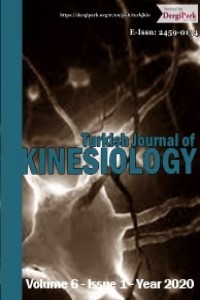Balancing the imbalance of stroke survivors with backward slope walking on differential treadmill gradients
Balancing the imbalance of stroke survivors with backward slope walking on differential treadmill gradients
___
- Agwubike EO, Agbonlahor EI. Kinematic analysis of retrolocomotion of NNPC personnel on treadmill of varying gradients. Journal of Health and Kinesiology, 2005; 6(1): 14-27.
- Agwubike EO, Agbonlahor EI. Comparison of Biomechanical changes between pro-locomotion and Retro-locomotion by NNPC personnel on treadmill. Journal of Kinetics and Health Education Perspective, 2007; 10: 214-232.
- Cirpriani DJ. Backward Walking at three levels of treadmill inclination: an electromyography and kinetics analysis. The Journal of Orthopeadic and Sports Physical Therapy, 1995; 22(3): 95-102.
- Corbin CB, Welk GJ, Corbin WR, Welk KA. Concerts of physical fitness: Active lifestyle for wellness (twelfth edition). Broston: McGram Hill, 2004.
- Heses S, Konrad M, Vhiemrock D. Treadmill with partial body weight support versus floor walking in hemiparetic subjects. Arch. Phys Med. Rehabil, 1999; 8: 121-127.
- Heses S, Werner C, Bardeleben A, Barbean H. Body weight supported treadmill training after stroke. Cure Atheroscler Rep, 2002; 3: 287-294.
- McArdle W D, Katch FI, Katch VI. Essential of exercise physiology, Philadephia: Lippincott Williams and Wilkings, 2000.
- Sims NR, Muyderman H. Mitochondria, oxidative metabolism and cell death in stroke. Biochemical et Biophysical Acta, 2009; 1802(1): 80-91.
- World Health Organization. Obesity preventing and managing the global Epidemic. WHO Technical Report 894. Gevenva: WHO, 2005.
- Yayın Aralığı: 4
- Başlangıç: 2015
- Yayıncı: Nurtekin Erkmen
Teddy BOFOSA, Betty MİANGİNDULA, Constant NKİAMA
Elvis L. AGBONHALOR, İsoken F. OSAGİEDE
The epidemiological profile of knee injury pattern among different divisional football players
Atiqur Rahman KHAN, Mohammad Jobair KHAN, Mohammad Delwer Hossain HAWLADER
Socio-demographic correlates of quality of life in spinal cord injured patients
Abiodun L. AZEEZ, Adebisi İ. HAMMED
Godefroid Kusuayi MABELE, Constant Nkiama EKİSAWA, Betty MİANGİNDULA, Christophe DELECLUSE, François Lepira BOMPEKA, Pierre AKİLİMALİ
